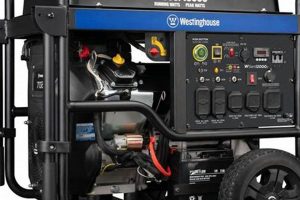This compact power source utilizes a two-stroke engine fueled by gasoline to generate electricity. Small and easily transportable, units of this type are typically employed for outdoor activities like camping and tailgating, as well as for backup power during outages. The two-stroke engine design offers a higher power-to-weight ratio compared to four-stroke engines, making these generators relatively lightweight and easy to move.
Portable generators offer crucial independent power capabilities for various situations. They provide a reliable source of electricity during emergencies, natural disasters, and power outages, ensuring essential appliances and devices continue to function. Their portability makes them ideal for recreational activities, construction sites, and remote locations lacking access to the electrical grid. This accessibility to power enhances safety, convenience, and productivity in numerous contexts. Historically, smaller, portable generators filled a niche for users needing limited, mobile power, while larger stationary generators provided whole-house backup. The advancement of engine and alternator technology has allowed for increasingly smaller and more powerful portable units.
Further exploration will delve into the specifics of operation, maintenance, safety considerations, and the various applications of this convenient power solution.
Operational Tips for Portable Generators
Safe and efficient operation of portable generators requires adherence to specific guidelines. These tips focus on maximizing performance while ensuring user safety and prolonging equipment lifespan.
Tip 1: Consult the Owner’s Manual: Before operating any generator, thoroughly review the manufacturer’s instructions. This document provides critical safety information and specific operating procedures tailored to the unit.
Tip 2: Proper Fueling: Always refuel the generator outdoors and allow the engine to cool completely before adding fuel. Gasoline spills pose a fire hazard. Use the recommended fuel type and avoid overfilling the tank.
Tip 3: Ventilation: Generators produce carbon monoxide, a colorless, odorless, and deadly gas. Operate the generator in a well-ventilated area, far from windows, doors, and vents. Never operate a generator indoors.
Tip 4: Grounding: Proper grounding is essential for electrical safety. Follow the grounding instructions provided in the owner’s manual to prevent electrical shock.
Tip 5: Load Management: Avoid overloading the generator. Determine the wattage requirements of devices and appliances and ensure the combined load does not exceed the generator’s rated output.
Tip 6: Regular Maintenance: Adhere to the manufacturer’s recommended maintenance schedule. This typically includes regular oil changes, air filter cleaning or replacement, and spark plug inspection.
Tip 7: Storage: Store the generator in a dry, well-ventilated area away from flammable materials. Drain the fuel tank or add fuel stabilizer before long-term storage.
Following these guidelines will ensure safe and reliable operation, extending the lifespan of the generator and minimizing potential hazards. Careful operation contributes significantly to both performance and safety.
With these operational tips covered, the following section will address common troubleshooting scenarios and offer solutions for typical issues encountered during generator operation.
1. Portability
Portability is a defining characteristic of generators like the Pulsar PG1202SA, directly influencing its usability and suitability for various applications. This feature dictates where and how the generator can be deployed, impacting its overall value for different users.
- Compact Design and Lightweight Construction:
The physical dimensions and weight significantly impact portability. Smaller, lighter generators are easier to transport and maneuver, making them ideal for activities like camping or tailgating. Materials used in the generator’s construction also play a role; robust yet lightweight materials like high-impact plastics and aluminum alloys contribute to both durability and ease of movement. This allows users to readily deploy power in various locations.
- Integrated Handles and Wheels:
Features like integrated handles, strategically placed lifting points, and built-in wheels significantly enhance portability. Ergonomic handles facilitate comfortable lifting, while durable wheels allow for easy transport across various terrains. These design elements minimize strain and simplify movement, crucial for users needing to relocate the power source frequently. Consider, for example, using the generator on a construction site where it might need repositioning throughout the workday.
- Size Relative to Power Output:
Balancing power output with physical size is a crucial aspect of portability. A compact generator delivering sufficient power for intended applications offers maximum utility. This balance makes it practical for powering essential equipment in remote locations or during emergencies. A smaller generator producing adequate power offers greater portability than a larger, more powerful unit when wattage demands are moderate.
- Impact on Practical Applications:
Portability expands the practical applications of a generator. It allows for reliable power in remote areas, during outdoor events, and in emergency situations where grid power is unavailable. This flexibility makes portable generators invaluable for disaster relief, remote work, and recreational activities. The compact nature facilitates deployment in diverse settings, maximizing its usefulness.
The portability of the Pulsar PG1202SA, and similar generators, directly impacts user experience and applicability. Its compact design, combined with features that aid transport, makes it a versatile power solution for various situations, underscoring the importance of portability in generator selection.
2. Two-stroke engine
The Pulsar PG1202SA utilizes a two-stroke engine, a design choice significantly impacting its characteristics and performance. Two-stroke engines complete a power cycle with two strokes (one piston up and down movement) per crankshaft revolution, unlike four-stroke engines, which require four. This fundamental difference leads to a higher power-to-weight ratio, a critical factor in the PG1202SA’s portability. The simpler design, with fewer moving parts than a four-stroke engine, also contributes to a more compact and lightweight unit, essential for a portable generator. However, this design necessitates mixing oil with the gasoline to lubricate internal components, a requirement demanding user attention to maintain the correct fuel-oil ratio. An incorrect mixture can lead to engine damage, highlighting the importance of adhering to manufacturer specifications.
This engine design choice influences several operational aspects. The higher power-to-weight ratio makes the PG1202SA easier to transport and maneuver, benefiting applications where portability is paramount, such as camping, tailgating, or providing power at remote job sites. The two-stroke engine’s typically higher revolutions per minute (RPM) contribute to increased power output for its size. However, this can also lead to higher noise levels and increased fuel consumption compared to equivalent four-stroke engines. The need for pre-mixed fuel, while adding a step to operation, simplifies the engine’s internal design, potentially reducing maintenance complexity in some areas.
Understanding the implications of the two-stroke engine in the PG1202SA is crucial for effective operation and maintenance. Recognizing the trade-offs between power, weight, noise, and fuel consumption allows users to make informed decisions regarding its suitability for specific needs. While the two-stroke design offers advantages in portability and power output, considerations regarding fuel mixture and potential noise levels must be factored into operational planning. This understanding ultimately contributes to safe, efficient, and responsible generator use, maximizing its benefits while mitigating potential drawbacks.
3. Gasoline-powered
The Pulsar PG1202SA’s gasoline-powered operation significantly influences its practicality and usability. Gasoline’s widespread availability and established distribution network contribute to the generator’s convenience. Users can readily refuel in most locations, unlike alternative fuels requiring specialized sourcing. This ease of refueling enhances the generator’s suitability for emergency preparedness, recreational activities, and remote applications where access to other fuel types might be limited. For instance, during a power outage, readily available gasoline allows for extended operation, crucial for powering essential appliances. Furthermore, gasoline’s established infrastructure supports consistent fuel quality, contributing to reliable engine performance. This reliability is paramount in situations where consistent power is essential.
Gasoline as a fuel source presents specific considerations. Storage requires attention to safety regulations due to flammability. Proper containers and ventilation are essential to mitigate fire hazards. The combustion process produces emissions, impacting air quality and necessitating operation in well-ventilated areas. These environmental considerations influence operational guidelines, impacting where and how the generator can be safely used. Advancements in engine technology strive to mitigate emissions, but understanding their presence remains crucial for responsible operation. Additionally, gasoline prices fluctuate, influencing the long-term operational costs. These fluctuating costs can impact budgeting for extended use, particularly in professional or commercial applications.
The PG1202SA’s gasoline-powered design offers practical benefits regarding fuel availability and established infrastructure. However, users must address inherent challenges related to storage, emissions, and price volatility. Balancing these factors ensures safe, responsible, and cost-effective operation, maximizing the generator’s utility while mitigating potential drawbacks. Understanding the implications of a gasoline-powered system provides users with the knowledge necessary for informed operation and contributes to a comprehensive awareness of its role in portable power generation.
4. Power Output
Power output is a critical specification for the Pulsar PG1202SA, directly determining its capability to operate various electrical devices and appliances. Understanding this aspect is essential for selecting appropriate applications and ensuring safe and efficient operation. Insufficient power output can lead to overloaded circuits and potential damage to both the generator and connected equipment. Conversely, excessive power output for the intended use represents unnecessary fuel consumption and potential engine strain. Therefore, accurate assessment of power requirements is crucial for maximizing the generator’s effectiveness.
- Rated Wattage and Starting Wattage:
Generators possess two key power ratings: rated (running) wattage and starting wattage. Rated wattage indicates the continuous power output the generator can sustain, while starting wattage represents the higher power surge required to start motor-driven appliances like refrigerators or power tools. The PG1202SA, like other generators, will have specific values for these ratings. For example, a refrigerator might require 1000 starting watts and 700 running watts. Matching these requirements to the generator’s capabilities is essential for reliable operation.
- Impact on Appliance Operability:
The generator’s power output dictates which appliances can be operated simultaneously. Exceeding the rated wattage will overload the generator, leading to potential shutdowns or damage. Users must calculate the combined wattage of intended devices to ensure they remain within the generator’s limits. For instance, attempting to run a high-wattage appliance like a space heater alongside other devices might exceed the generator’s capacity, resulting in operational failure.
- Relationship to Fuel Consumption:
Power output directly influences fuel consumption. Operating the generator near its maximum rated wattage will consume fuel more quickly than lighter loads. Understanding this relationship allows users to estimate runtimes and plan refueling accordingly. Running a smaller load, such as a few lights and a laptop, will consume fuel at a lower rate than powering a larger appliance like an air conditioner.
- Practical Application Examples:
Consider scenarios like camping or tailgating. Knowing the PG1202SA’s power output allows users to determine which devices can be powered, such as lights, small appliances, or electronic devices. During a power outage, this knowledge is crucial for prioritizing essential appliances within the generator’s capacity, ensuring critical functionality. Understanding power output limitations allows for informed decisions regarding device usage and operational planning.
Selecting the correct generator for specific applications hinges on a clear understanding of power output. The PG1202SA’s rated and starting wattage dictate its capabilities and limitations, influencing its suitability for various tasks. Matching these specifications to the power requirements of intended devices ensures safe, reliable, and efficient operation. Careful consideration of power output contributes significantly to successful generator utilization and avoids potential issues arising from overloads or insufficient capacity, maximizing its value as a portable power solution.
5. Runtime
Runtime represents a crucial operational parameter for the Pulsar PG1202SA, defining the duration the generator can operate continuously on a single fuel tank. This duration directly impacts its practical applicability and influences user planning for various scenarios. Several factors influence runtime, including the generator’s fuel tank capacity, engine efficiency, and the power demand from connected devices. Higher power demands typically result in shorter runtimes due to increased fuel consumption. Understanding the interplay of these factors allows users to optimize runtime and ensure the generator meets specific power needs for the required duration. For instance, operating the generator at a lower load, such as powering essential lights and devices rather than high-wattage appliances, can significantly extend runtime.
The practical significance of runtime becomes evident in various real-world applications. During a power outage, runtime determines the duration essential appliances can function before refueling becomes necessary. For camping or outdoor events, runtime dictates how long the generator can provide power for lighting, cooking, or entertainment. Consider a scenario where the PG1202SA powers essential medical equipment during a power outage. Understanding its runtime allows users to plan for necessary refueling or alternative power sources, ensuring uninterrupted operation. Similarly, for recreational activities, estimating runtime enables users to determine the amount of fuel needed for the event’s duration, preventing unexpected power interruptions. Accurate runtime estimation is crucial for effective power management in diverse situations.
In conclusion, runtime stands as a key consideration for users of the Pulsar PG1202SA. Careful evaluation of power demands, fuel tank capacity, and expected operating conditions allows for accurate runtime estimation. This understanding facilitates informed planning for various applications, from emergency preparedness to recreational activities. Optimizing power usage and anticipating refueling needs ensures the generator effectively meets power demands for the required duration, maximizing its utility as a portable power source. The interplay between runtime and fuel consumption underscores the importance of efficient power management for maximizing the generator’s operational capabilities.
6. Noise Levels
Noise levels represent a significant operational consideration for the Pulsar PG1202SA and similar generators. These units produce noise primarily due to the combustion process within the two-stroke engine and the operation of the cooling fan. The engine’s high RPM and the rapid expulsion of exhaust gases contribute to the overall sound level. Understanding the factors contributing to noise production allows for informed decisions regarding operational placement and potential mitigation strategies. Operating the generator farther away from populated areas or using sound-dampening barriers can help minimize noise impact. For example, during a camping trip, positioning the generator a reasonable distance from campsites contributes to a more peaceful environment.
Noise levels influence the suitability of the PG1202SA for various applications. In noise-sensitive environments, such as residential areas or during nighttime operation, higher noise levels can be disruptive. Considering the proximity of neighbors or noise ordinances is essential for responsible operation. Using the generator during daytime hours in residential areas or selecting quieter locations for recreational use demonstrates consideration for others. Furthermore, prolonged exposure to high noise levels can pose health risks, highlighting the importance of operational practices that minimize noise impact. Wearing hearing protection during extended operation exemplifies proactive noise management. The generator’s noise output, measured in decibels (dB), provides a quantifiable metric for assessing its potential impact on surrounding areas and informs decisions regarding appropriate usage.
In conclusion, noise levels constitute a critical factor influencing the practical application of the Pulsar PG1202SA. Understanding the sources of noise production and their potential impact on surrounding environments promotes responsible generator operation. Careful planning regarding placement, operational timing, and potential mitigation measures minimizes disruption and contributes to a safer and more considerate user experience. Evaluating noise levels alongside power output, runtime, and other operational parameters ensures the generator aligns with specific needs and environmental considerations, maximizing its utility while minimizing potential drawbacks.
7. Maintenance Requirements
Regular maintenance is essential for the Pulsar PG1202SA’s longevity, reliability, and safe operation. Neglecting these requirements can lead to performance degradation, premature failure, and potential safety hazards. Adhering to a consistent maintenance schedule ensures optimal functionality and extends the generator’s lifespan, maximizing its value as a portable power source. This proactive approach minimizes downtime and contributes to reliable performance when needed most.
- Regular Oil Changes:
Two-stroke engines, like the one in the PG1202SA, require regular oil changes due to the fuel-oil mixture used for lubrication. Old or contaminated oil reduces lubrication effectiveness, increasing engine wear and potentially leading to overheating or seizures. Following the manufacturer’s recommended oil change intervals, typically based on operating hours, is crucial for maintaining engine health. Using the correct oil type and quantity, as specified in the owner’s manual, ensures optimal engine performance and longevity. For example, failing to change the oil regularly can lead to costly repairs or even engine replacement.
- Air Filter Maintenance:
A clean air filter ensures optimal airflow to the engine, promoting efficient combustion. A clogged air filter restricts airflow, reducing power output, increasing fuel consumption, and potentially causing engine damage. Regular cleaning or replacement of the air filter, as outlined in the owner’s manual, prevents these issues and maintains engine performance. Inspecting the air filter frequently, especially in dusty environments, allows for timely cleaning or replacement. Neglecting air filter maintenance can lead to decreased engine efficiency and potential long-term damage.
- Spark Plug Inspection and Replacement:
The spark plug ignites the fuel-air mixture within the engine cylinder. A worn or fouled spark plug can cause misfires, reducing power output, increasing fuel consumption, and making starting difficult. Regular inspection and replacement of the spark plug, as recommended by the manufacturer, ensures reliable engine starting and efficient operation. Visually inspecting the spark plug for wear or fouling allows for timely replacement, preventing performance issues. Ignoring spark plug maintenance can result in unreliable engine operation and potential starting difficulties.
- Fuel System Maintenance:
Proper fuel system maintenance prevents issues related to fuel quality and delivery. Draining the fuel tank during periods of extended storage prevents stale fuel from causing starting problems or gumming up the carburetor. Using fuel stabilizer helps maintain fuel quality during storage, ensuring reliable starting after periods of inactivity. Regularly inspecting fuel lines for cracks or leaks prevents fuel leaks and potential fire hazards. Proper fuel system maintenance contributes to consistent and reliable engine performance and minimizes potential safety risks.
Consistent adherence to these maintenance requirements significantly impacts the PG1202SA’s performance, reliability, and lifespan. Proactive maintenance minimizes the risk of breakdowns, extends the generator’s operational life, and contributes to safe and efficient power generation. Regular maintenance is an investment in the generator’s long-term performance, ensuring reliable power when needed. By understanding and fulfilling these maintenance requirements, users maximize the generator’s value and ensure its readiness for various applications, from emergency power supply to recreational use.
Frequently Asked Questions
This section addresses common inquiries regarding the operation, maintenance, and application of portable generators, specifically focusing on practical considerations for users.
Question 1: What type of oil should be used in a two-stroke generator?
Two-stroke generators require a specific type of oil designed for two-stroke air-cooled engines. Using standard automotive oil will damage the engine. Consult the owner’s manual for the manufacturer’s recommended oil type and the correct fuel-oil mixture ratio. Using the incorrect oil or mixture ratio can lead to significant engine damage.
Question 2: How long can a portable generator run continuously?
Runtime depends on several factors, including fuel tank capacity, engine efficiency, and the load placed on the generator. Higher power demands result in shorter runtimes. Consult the owner’s manual for estimated runtimes under various load conditions. Typical runtimes range from several hours to over ten hours on a single tank, depending on these factors.
Question 3: Can a portable generator be used indoors?
Never operate a portable generator indoors or in enclosed spaces. Generators produce carbon monoxide, a colorless, odorless, and deadly gas. Operate the generator outdoors in a well-ventilated area, far from windows, doors, and vents. Ensuring adequate ventilation is critical for safe operation.
Question 4: What precautions should be taken when refueling a portable generator?
Always turn off the generator and allow it to cool completely before refueling. Gasoline spills on a hot engine pose a fire hazard. Refuel outdoors in a well-ventilated area. Avoid overfilling the fuel tank. These precautions minimize fire risks and ensure safe refueling procedures.
Question 5: How should a portable generator be stored?
Store the generator in a dry, well-ventilated area, away from flammable materials. Drain the fuel tank or add fuel stabilizer before long-term storage. This prevents stale fuel from causing starting problems and protects the fuel system from corrosion.
Question 6: What is the difference between starting watts and running watts?
Starting watts refers to the surge of power required to start motor-driven appliances. Running watts represents the continuous power the generator can supply. Appliances with electric motors, like refrigerators or air conditioners, require higher starting wattage than their running wattage. Understanding this distinction is crucial for selecting a generator with sufficient capacity for intended applications.
Understanding these frequently asked questions promotes safe and effective generator operation. Consulting the owner’s manual for model-specific information is crucial for optimal performance and safe usage practices.
The following section offers troubleshooting tips for common issues encountered during generator operation.
Conclusion
This exploration of the Pulsar PG1202SA portable 2-cycle gas generator encompassed key aspects of its operation, maintenance, and practical applications. Its compact, portable design, powered by a two-stroke gasoline engine, offers convenient power generation for various scenarios, from recreational activities to emergency power supply. Understanding the nuances of its power output, runtime, noise levels, and specific maintenance requirements is crucial for safe, efficient, and responsible use. Careful consideration of these factors ensures users can effectively harness its capabilities while mitigating potential drawbacks. Operational guidelines regarding fueling, ventilation, and grounding contribute significantly to safe usage practices and minimize potential hazards.
Portable generators serve a crucial role in modern society, offering independent power solutions for diverse needs. As technology advances, further enhancements in fuel efficiency, noise reduction, and emission control will continue to refine these essential power sources. Responsible operation, coupled with diligent maintenance, maximizes the lifespan and effectiveness of these devices, ensuring reliable power availability when and where it is needed most. The ability to generate independent power empowers individuals, businesses, and communities to navigate unforeseen circumstances and maintain essential functions, underscoring the significance of portable generators in enhancing resilience and preparedness.






